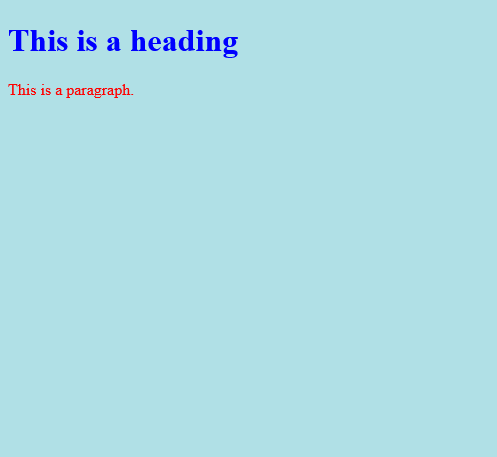Tips (Total 6)
# Tips-1) What is HTML CSS
CSS stands for Cascading Style Sheets.
CSS saves a lot of work. It can control the layout of multiple web pages all at once.
Cascading Style Sheets (CSS) is used to format the layout of a webpage.
With CSS, you can control the color, font, the size of text, the spacing between elements, how elements are positioned and laid out, what background images or background colors are to be used, different displays for different devices and screen sizes, and much more!
Tip: The word cascading means that a style applied to a parent element will also apply to all children elements within the parent. So, if you set the color of the body text to "blue", all headings, paragraphs, and other text elements within the body will also get the same color (unless you specify something else)!
# Tips-2) How to use CSS
CSS can be added to HTML documents in 3 ways:
- Inline - by using the
styleattribute inside HTML elements - Internal - by using a
<style>element in the<head>section - External - by using a
<link>element to link to an external CSS file
The most common way to add CSS, is to keep the styles in external CSS files. However, in this tutorial we will use inline and internal styles, because this is easier to demonstrate, and easier for you to try it yourself.
Example of using CSS under HTML Inline CSS Style
Inline - by using the style attribute inside HTML elements
index.html
Example:
HTML
<h1 style="color:blue;">A Blue Heading</h1>
<p style="color:red;">A red paragraph.</p>
Example of using CSS under HTML Internal CSS Style
Internal Style defines <style>body {background-color: powderblue;}</style> which you can add in a html page likely following example.
index.html
Example:
HTML
<!DOCTYPE html>
<html>
<head>
<style>
body {background-color: powderblue;}
h1 {color: blue;}
p {color: red;}
</style>
</head>
<body>
<h1>This is a heading</h1>
<p>This is a paragraph.</p>
</body>
</html>
Output should be:

Example of using CSS under HTML External CSS Style
External CSS defines <link rel="stylesheet" href="styles.css"> tag. Which can be used under href link .css file. Following is the best example.
index.html
Example:
HTML
<!DOCTYPE html>
<html>
<head>
<link rel="stylesheet" href="https://itupto.com/style.css">
</head>
<body>
<h1>This is a heading</h1>
<p>This is a paragraph.</p>
</body>
</html>
Output should be:

# Tips-3) How to use HTML Inline CSS
An inline CSS is used to apply a unique style to a single HTML element.
An inline CSS uses the style attribute of an HTML element.
The following example sets the text color of the <h1> element to blue, and the text color of the <p> element to red:
Full Example of HTML Inline CSS
The following example sets the text color of the <h1> element to blue, and the text color of the <p> element to red:
index.html
Example:
HTML
<!DOCTYPE html>
<html>
<body>
<h1 style="color:blue;">A Blue Heading</h1>
<p style="color:red;">A red paragraph.</p>
</body>
</html>
Output should be:

# Tips-4) How to use HTML Internal CSS
An internal CSS is used to define a style for a single HTML page.
An internal CSS is defined in the <head> section of an HTML page, within a <style> element.
Full Example of HTML Internal CSS
The following example sets the text color of ALL the <h1> elements (on that page) to blue, and the text color of ALL the <p> elements to red. In addition, the page will be displayed with a "powderblue" background color:
index.html
Example:
HTML
<!DOCTYPE html>
<html>
<head>
<style>
body {background-color: powderblue;}
h1 {color: blue;}
p {color: red;}
</style>
</head>
<body>
<h1>This is a heading</h1>
<p>This is a paragraph.</p>
</body>
</html>
Output should be:

# Tips-5) How to use HTML External CSS
An external style sheet is used to define the style for many HTML pages.
Full Example of HTML External CSS
To use an external style sheet, add a link to it in the <head> section of each HTML page:
<!DOCTYPE html>
<html>
<head>
<link rel="stylesheet" href="https://www.w3schools.com/w3css/4/w3.css">
</head>
<body>
<h1>This is a heading</h1>
<p>This is a paragraph.</p>
</body>
</html>
Output should be:

# Tips-6) How to create HTML CSS Colors, Fonts and Sizes
Here, we will demonstrate some commonly used CSS properties. You will learn more about them later.
Full Example of CSS Colors, Fonts and Sizes
The CSS color property defines the text color to be used. The CSS font-family property defines the font to be used. The CSS font-size property defines the text size to be used.
index.html
Example:
HTML
<!DOCTYPE html>
<html>
<head>
<style>
h1 {
color: blue;
font-family: verdana;
font-size: 300%;
}
p {
color: red;
font-family: courier;
font-size: 160%;
}
</style>
</head>
<body>
<h1>This is a heading</h1>
<p>This is a paragraph.</p>
</body>
</html>
Output should be:
